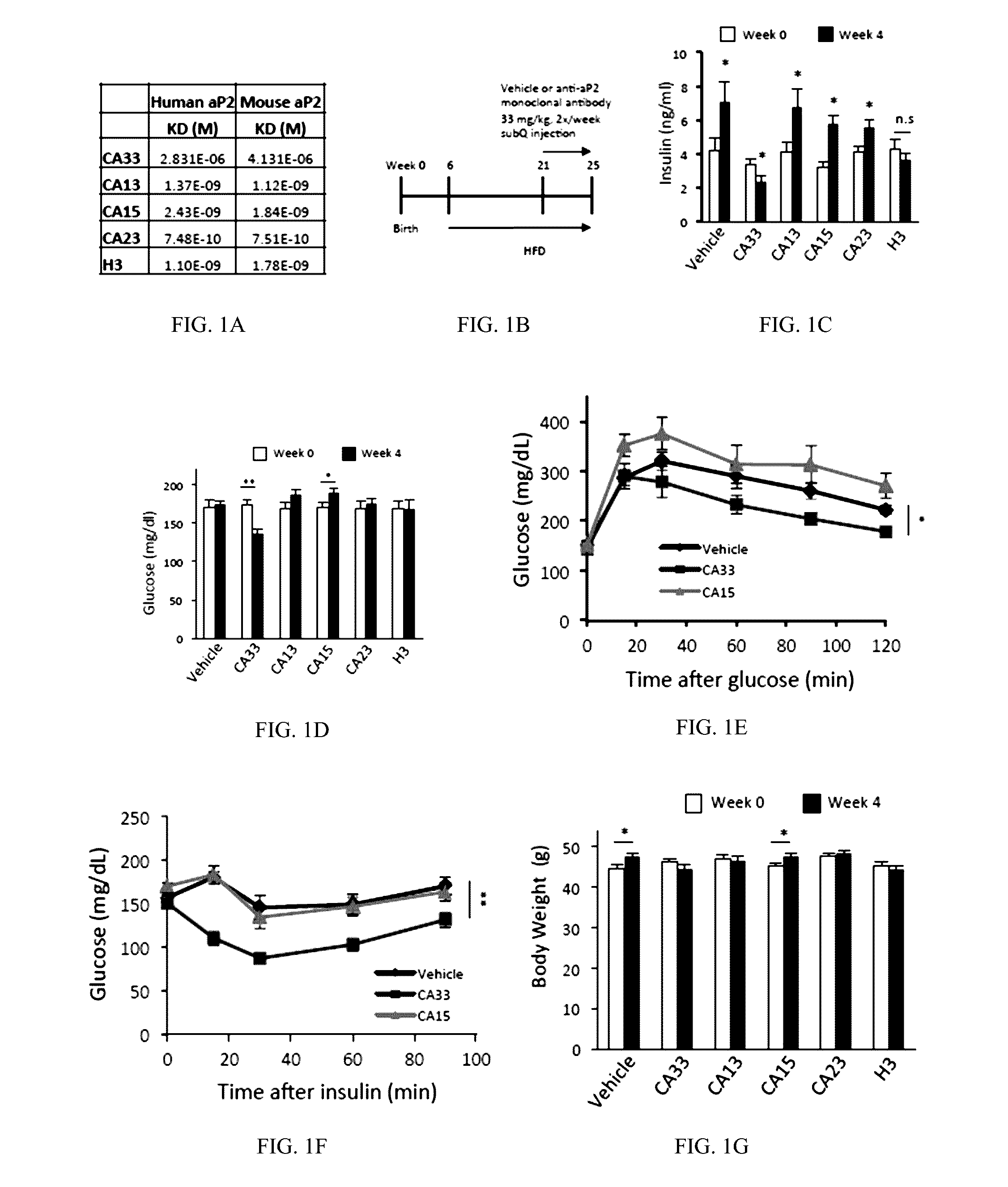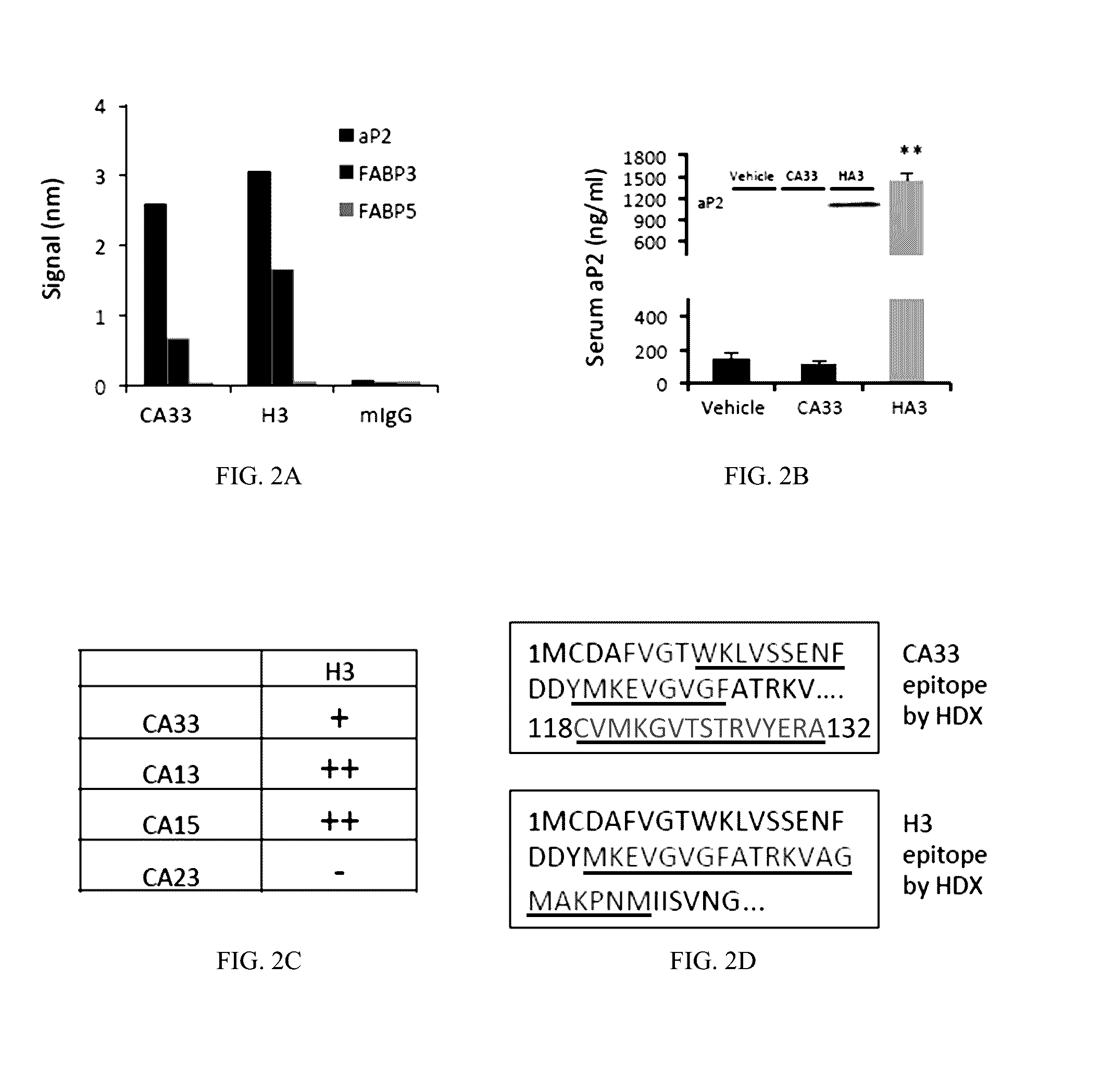Anti-aP2 Antibodies and Antigen Binding Agents to Treat Metabolic Disorders
a metabolic disorder and anti-ap2 technology, applied in the field of metabolic disorders, can solve the problems of mab 2e4 treatment failing to affect hfd-induced insulin tolerance, distorted increase body weight, etc., and achieve the effect of improving the ability to neutralize secreted ap2, significant inhibitory effect on ap2-mediated, and low binding affinity
- Summary
- Abstract
- Description
- Claims
- Application Information
AI Technical Summary
Benefits of technology
Problems solved by technology
Method used
Image
Examples
example 1
Preparation of an Illustrative Monoclonal Antibody Targeting Secreted aP2 Animals
[0591]Animal care and experimental procedures were performed with approval from animal care committees of Harvard University. Male mice (leptin-deficient (ob / ob) and diet induced obese (DIO) mice with C57BL / 6J background) were purchased from The Jackson Laboratory (Bar Harbor, Me.) and kept on a 12-hour light / dark cycle. DIO mice with C57BL / 6J background were maintained on high-fat diet (60% kcal fat, Research Diets, Inc., D12492i) for 12 to 15 weeks before starting treatment except in clamp studies, for which they were on HFD for 20 weeks. Leptin-deficient (ob / ob) mice were maintained on regular chow diet (RD, PicoLab 5058 Lab Diet). Animals used were 18 to 31 weeks of age for dietary models and 9 to 12 weeks of age for the ob / ob model. In all experiments, at least 7 mice in each group were used, unless otherwise stated in the text. The mice were treated with 150 μl PBS (vehicle) or 1.5 mg / mouse (˜33 m...
example 2
Anti-aP2 Monoclonal Antibody (CA33) for the Treatment of Type 1 Diabetes CA33 Treatment is Protective Against Hyperglycemia and Mortality in the NOD Mouse Model of Type 1 Diabetes
[0621]A model of Type 1 diabetes (T1D) in which diabetes onset is spontaneous, the NOD mouse (S. Makino, K. Kunimoto, Y. Murakoa, Y. Mizushima, K. Katagiri, Y. Tochino. Breeding of a non-obese, diabetic strain of mice. Jikken-dobutsu, Experimental animals 29, 1-13 (1980)), was used to examine the effects of CA33 treatment on diabetes incidence and mortality. Animal care and experimental procedures were performed with approval from animal care committees of Harvard University. Eight-week old female NOD mice were injected subcutaneously with either vehicle or CA33. For the first 6 weeks of treatment the CA33 treated mice were injected with 1 mg / injection, which corresponds to ˜45 mg / kg dose, twice weekly. Starting at the seventh week of the study CA33 treated mice were injected with a 30 mg / kg dose of CA33 tw...
example 3
Anti-aP2 Monoclonal Antibody for the Treatment, Reduction or Prevention of Atherosclerosis
Animals
[0639]Animal care and experimental procedures were performed with approval from animal care committees of Harvard University. Male ApoE− / − mice in the C57BL / 6J background (Jackson Laboratory) were kept on a 12-h light cycle and were fed a high-cholesterol atherogenic western diet (D12079B: 21% fat, 0.21% cholesterol; Research Diets) ad libitum, beginning at 4-5 weeks of age. The mice were treated by subcutaneous administration of vehicle or antibody (33 mg / kg) for 12 weeks starting at 6-weeks of age.
Assessment of Atherosclerotic Lesions
[0640]Mice were sacrificed and flushed with saline and then 10% neutral buffered formalin solution by injection through the left ventricle. The aorta was dissected from the proximal aorta to the iliac bifurcation, and the aortae were pinned out in an en face preparation. En face pinned-out aortas were stained with Sudan IV.
[0641]Quantitation of lesion area...
PUM
| Property | Measurement | Unit |
|---|---|---|
| Molar density | aaaaa | aaaaa |
| Length | aaaaa | aaaaa |
| Dynamic viscosity | aaaaa | aaaaa |
Abstract
Description
Claims
Application Information
 Login to View More
Login to View More - R&D
- Intellectual Property
- Life Sciences
- Materials
- Tech Scout
- Unparalleled Data Quality
- Higher Quality Content
- 60% Fewer Hallucinations
Browse by: Latest US Patents, China's latest patents, Technical Efficacy Thesaurus, Application Domain, Technology Topic, Popular Technical Reports.
© 2025 PatSnap. All rights reserved.Legal|Privacy policy|Modern Slavery Act Transparency Statement|Sitemap|About US| Contact US: help@patsnap.com



